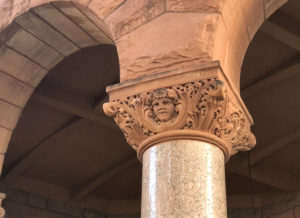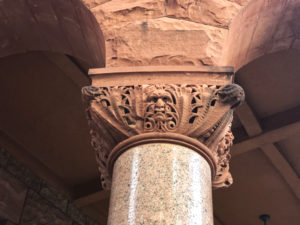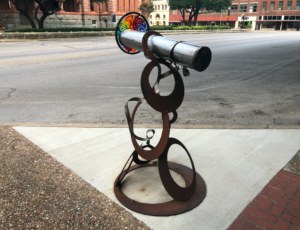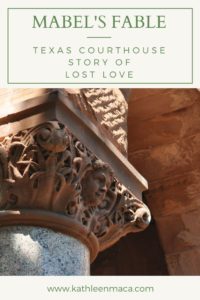Tag: Waxahachie
Face It…Ellis County Courthouse Has Quite a Story!
Stone emojis? Well, kind of! These faces silently tell the story of an unrequited love in Ellis County long ago.
The courthouse itself is exquisite. This 1897 Romanesque Revival stunner was designed by architect J. Riely Gordon. If you’re a fan of Texas courthouses, you’ve heard his name before, since he designed 18 of them! But this one is undisputedly his masterpiece.
I promise to tell you more about this beauty another time, but for now we’re just going to talk about those faces! If you feel as if someone is watching you as your walk around the grounds of the courthouse square, you’re probably right.
MABEL’S FABLE
The story goes that sculptor Harry Herley arrived in Waxahachie in 1895 to work on carvings for the courthouse project during it’s construction. The itinerant English artist moved into Mama Frame’s boarding house, where he met and fell in love with her beautiful 16-year-old daughter Mabel.
As his work continued on the courthouse, Harry’s love for Mabel grew, and he carved her angelic countenance to top the exterior columns of the courthouse.
But, as fate would have it, the love was unrequite d and Mabel discouraged his constant attentions. As it became apparent to Harry that his love wasn’t returned, his disappointment slowly turned into bitterness, and the faces he carved to represent Mabel progressed from beautiful to grotesque and twisted. A lasting revenge for his broken heart.
d and Mabel discouraged his constant attentions. As it became apparent to Harry that his love wasn’t returned, his disappointment slowly turned into bitterness, and the faces he carved to represent Mabel progressed from beautiful to grotesque and twisted. A lasting revenge for his broken heart.
The townspeople weren’t too happy about the unattractive faces on the courthouse they had spend so much money to build, and one story relates that the cattlemen and farmers even tarred and feathered poor ol’ Harry and ran him out of town on a rail.
It’s a sad, but terrific tale ripe for retelling through the generations.
Spoiler alert: If you’re charmed by the legend and would prefer
to leave it at that . . .you might want to stop reading this now.
THE TRUTH
Mabel’s mother Hattie, although a widow, didn’t seem to be running a boarding house according to the federal census. Even if she had been, the chances are that Herley never met the Frame family.
The biggest obstacle to this story were the characters were when it was supposedly taking place.
The stone sculptures for the courthouse were sub-contracted to the Dallas firm of German stonemason Theodore Beilharz. Hervey, who worked for the company at the time, is created with carving the exquisite red sandstone capitals perched atop the polished pink granite columns, but he also supervised other carvers who worked on the project.
The carvings would have been created in the Beilharz’s Pacific and Hawkins Stoneyard in Dallas and shipped to Waxahachie by rail as finished pieces, ready to mount in place.
 So…if Hervey wasn’t actually in Waxahachie, he certainly wasn’t occupied falling in love with one of its residents.
So…if Hervey wasn’t actually in Waxahachie, he certainly wasn’t occupied falling in love with one of its residents.
There’s no record of Hervey coming to town until the summer of 1896, a year after his work for the courthouse was completed, to work on another stone carving assignment for a prominent businessman.
It was on this trip that he met local girl Minnie Hodges, whom he married in August of that year.
Many of Reilly’s courthouses feature faces and gargoyles, appropriate for the Romanesque style, and its likely that the design or at least the theme for the faces was under his direction. Unfortunately no records show what the intended meaning of the progression was meant to represent…which opens them up to storytelling.
It’s still a good story, and I bet if we checked back in a hundred years..it will still be told.
Most local lore has elements of truth woven into it. Does knowing the true stories “ruin it” for you, or make it more interesting?


And what’s a Texas legend without a song to go along with it? To listen to Jeremiah Richey’s ditty about the Eliis County Courthouse faces, click here.












